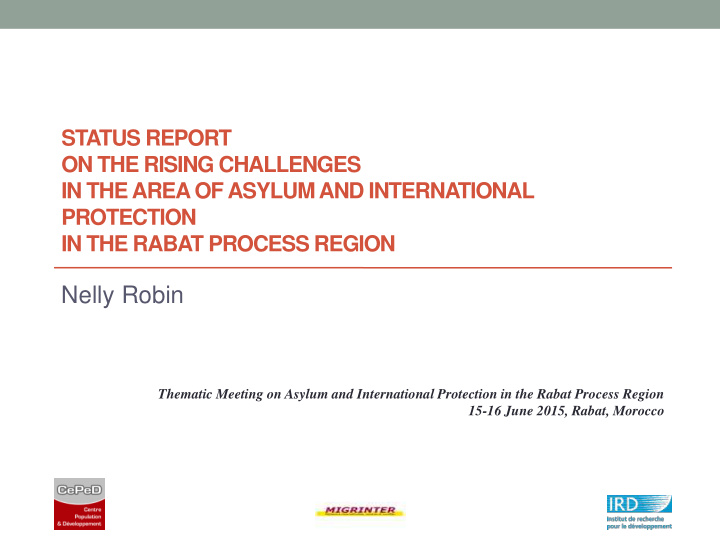



STATUS REPORT ON THE RISING CHALLENGES IN THE AREA OF ASYLUM AND INTERNATIONAL PROTECTION IN THE RABAT PROCESS REGION Nelly Robin Thematic Meeting on Asylum and International Protection in the Rabat Process Region 15-16 June 2015, Rabat, Morocco
Thematic meeting on asylum and international protection in the Rabat Process Region Nelly ROBIN 15-16 June 2015, Rabat, Morocco International protection • Fourth pillar of the Rabat Process Rome Declaration (2015-2017) “ respect for access to international protection and the principle of non-refoulement of asylum seekers and refugees (...) also constitute a priority objective ” + other vulnerable populations: unaccompanied minors, victims of human trafficking, smuggled migrants ➪ What are the challenges and what are the solutions?
Thematic meeting on asylum and international protection in the Rabat Process region Nelly ROBIN 15-16 June 2015, Rabat, Morocco Refugees and displaced persons in the countries of the Rabat Process • Developing countries: 86 % of global refugees (2013) • In 2013, all countries of the Rabat Process received approximately 2,500,000 refugees • A 43 % increase in asylum seekers in the EU (2013-2014) • Five Rabat Process countries are among the top ten African receiving countries • Chad, at the crossroads of the Processes’s conflict zones • Egypt, between the Middle East and East Africa
Thematic meeting on asylum and international protection in the Rabat Process region Nelly ROBIN 15-16 June 2015, Rabat, Morocco Evolution of refugees in the Rabat Process Region between 2011 and 2013
Thematic meeting on asylum and international protection in the Rabat Process region Nelly ROBIN 15-16 June 2015, Rabat, Morocco International, regional and national legal context • The 1951 Convention Relating to the Status of Refugees and the 1967 Protocol • Common European Asylum System (CEAS, since 1999) • Charter of Fundamental Rights of the European Union (2000) • Dublin Regulation (2003): principle of examining asylum applications • Directives (2001- 2005), including the “ qualification directive” • OAU Convention Governing the Specific Aspects of Refugee Problems in Africa (1969) • National legislations • EU Member States: adoption of a national legislation • African states: a more heterogeneous situation but reforms are underway
Thematic meeting on asylum and international protection in the Rabat Process region Nelly ROBIN 15-16 June 2015, Rabat, Morocco The contemporary causes of asylum are complex and multiple • Continuing conflicts in several Western and Central African states • Central African crisis: unprecedented population flows • Malian crisis: voluntary returns slowed down by anew fighting in May 2014 • Nigerian crisis: displacements due to Boko Haram violence • The humanitarian consequences of the conflicts in Syria and Iraq on the countries of North Africa , in particular on Libya
Thematic meeting on asylum and international protection in the Rabat Process region Nelly ROBIN 15-16 June 2015, Rabat, Morocco General Issues • The diversity and complexity of current displacements • Increase in mixed flows • Evolution of the international refugee protection regime in the light of the current geopolitical context • The territoriality of asylum • The duration of asylum and the level of guaranteed protection Finding new forms of international cooperation to deal with the protection crisis
Thematic meeting on asylum and international protection in the Rabat Process region Nelly ROBIN 15-16 June 2015, Rabat, Morocco Current solutions and solutions to be explored • Three traditional sustainable solutions • Voluntary return • Resettlement • Local integration • Other favourable solutions • Protection of cross-border refugees • Mobility Partnerships for EU-African Countries • Relocation
Thematic meeting on asylum and international protection in the Rabat Process region Nelly ROBIN 15-16 June 2015, Rabat, Morocco Progress to be achieved by strengthening • Asylum systems and national asylum legislation , in compliance with international norms, • Protection issues within national poverty reduction strategies , • The connections between international protection and development , particularly within the framework of regional protection programmes, • Measures designed to rescue persons in distress at sea (Search and Rescue - SAR), And • Organising information campaigns to raise awareness and inform the persons in question of the risks they face when taking irregular channels, • Developing legal alternatives to irregular migration .
Thank you for your attention
Recommend
More recommend